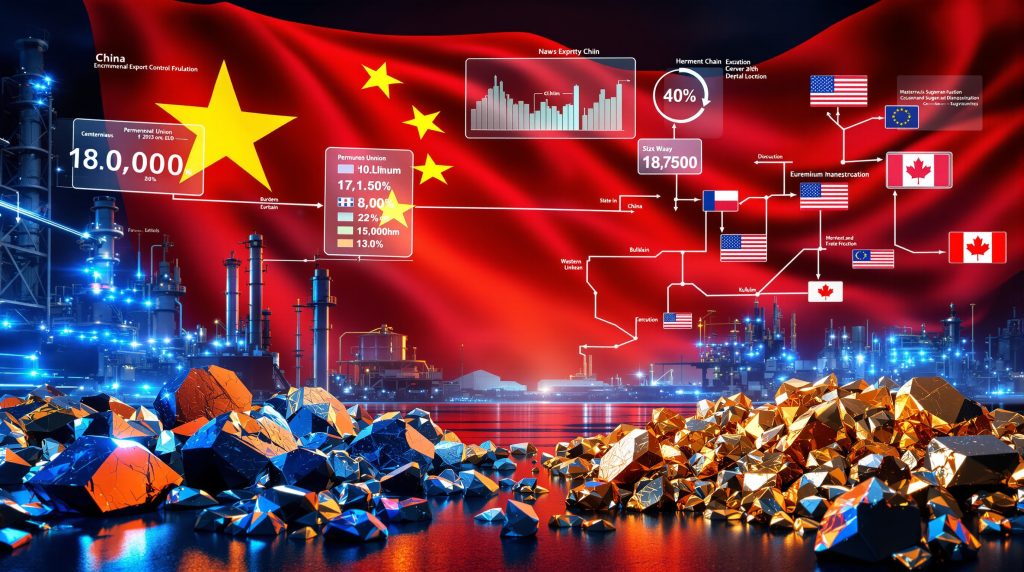Understanding China's Strategic Export Control Framework
China's rare earth export controls have emerged as a pivotal component of Beijing's strategic shift in November 2025, representing a fundamental evolution in global critical minerals policy. Rather than simply limiting raw material exports through quotas, Beijing has implemented sophisticated controls targeting the technological infrastructure that enables rare earth processing capabilities worldwide.
Furthermore, this policy transformation extends beyond traditional trade restrictions to encompass the entire rare earth value chain. The new framework prevents technological transfer while maintaining China's dominance in processing capabilities, creating structural dependencies that persist regardless of mining location.
The November 2025 Policy Shift – Beyond Traditional Trade Restrictions
On October 9, 2025, China's Ministry of Commerce and the General Administration of Customs jointly announced comprehensive export control measures targeting rare earth elements, lithium batteries, and diamond technologies. These controls became effective November 8, 2025, marking the first comprehensive rare earth policy since the 2010 quotas that triggered a World Trade Organization dispute.
The new framework represents a strategic transition from volume-based restrictions to capability-based controls. This approach prevents technological transfer while maintaining China's dominance across the entire rare earth value chain. The policy encompasses equipment classified under export codes 2B902 and 1C914, creating immediate bottlenecks for Western processing operations.
However, the implications of these bismuth export controls demonstrate how Beijing is expanding commodity leverage across multiple strategic materials simultaneously.
Technological Capability Control vs. Volume-Based Limitations
Traditional trade measures focused on limiting the quantity of raw materials leaving China. The November 2025 controls target the machinery and know-how required to transform rare earth concentrates into refined products. This creates a structural dependency that extends far beyond simple supply quotas.
The implications are profound. Even nations with domestic rare earth mining operations cannot achieve processing independence without access to Chinese separation equipment and technical expertise. This technological chokepoint ensures China maintains leverage over global supply chains regardless of mining location.
In addition, the broader context of critical minerals & energy security highlights how these controls align with China's comprehensive strategy across the energy transition supply chain.
Legal Framework Under China's Export Control Law
The controls operate under China's Export Control Law, which cites national security and non-proliferation commitments as primary justification. This legal foundation provides Beijing with broad discretionary authority to modify restrictions based on geopolitical considerations.
Under the licensing regime, all exporters must declare rare earth-related products as Dual-Use Items and obtain special permits. Customs authorities can question the completeness, accuracy, and authenticity of declared information, with goods remaining frozen during questioning periods that can extend for weeks or months.
What Equipment and Materials Face New Export Restrictions?
China's November 2025 export controls encompass a comprehensive range of processing equipment and strategic materials essential for rare earth production. The restrictions target both upstream separation technology and downstream heavy rare earth elements critical for advanced manufacturing applications.
Processing and Separation Technology Under Control
The equipment restrictions focus on three primary categories of machinery essential for rare earth processing operations.
Separation and Purification Equipment:
• Centrifugal extraction systems with specific volume parameters
• Extraction tanks with mixing chamber volumes between 0.5 and 14.2 cubic meters
• Intelligent continuous impurity removal and precipitation equipment for ion-adsorption rare earth ores with daily leaching solution processing capacity ≥5,000 cubic meters
• Vacuum furnace technologies for metal production
Metal Production Equipment Parameters:
• Vacuum induction reduction furnaces
• Vacuum carbon tube furnaces
• Specific equipment and electrolytic cells for rare earth metal electrolysis
| Equipment Category | Specifications Under Control | Strategic Impact |
|---|---|---|
| Centrifugal Extraction | Volume-specific parameters | Prevents separation capability |
| Vacuum Furnaces | Temperature and cooling specifications | Blocks metal production |
| Electrolytic Cells | Rare earth metal electrolysis systems | Controls refining capacity |
| Processing Equipment | Daily capacity ≥5,000 cubic meters | Limits industrial scale operations |
The complexity of rare earth separation creates significant technical barriers to entry. The process typically requires approximately 27 steps to produce a range of products, representing formidable challenges for nations attempting to establish independent processing capabilities.
Heavy Rare Earth Elements Now Subject to Licensing
China's November 2025 controls specifically target five critical heavy rare earth elements that command premium pricing due to their strategic importance in high-technology applications.
"The controlled heavy rare earth elements represent the crown jewels of critical mineral security, with applications spanning electric vehicle motors, wind turbine generators, and defense electronics systems where performance requirements exceed the capabilities of light rare earth alternatives."
Controlled Heavy Rare Earth Elements:
• Holmium – Essential for high-strength permanent magnets in wind turbine applications
• Erbium – Critical for fiber optic communications and laser technologies
• Thulium – Used in medical imaging and portable X-ray equipment
• Europium – Vital for LED phosphors and display screen technologies
• Ytterbium – Required for fiber laser systems and atomic clocks
The strategic significance of these elements extends beyond their industrial applications. Heavy rare earths enable high-coercivity magnet alloys that maintain magnetic strength at extreme temperatures, making them indispensable for electric vehicle motors and wind turbine generators where performance reliability is paramount.
Permanent Magnet Manufacturing Equipment Restrictions
The controls extend to specialized equipment essential for permanent magnet production, targeting the entire manufacturing process from raw material preparation through final product sintering.
Magnet Production Equipment Under Control:
• Vacuum induction strip casting furnace limitations
• Hydrogen decrepitation and airflow mill controls
• Specialized forming press and sintering equipment parameters
• Vacuum sintering furnaces with cooling times ≤20 minutes and heating temperatures between 500-1,200°C
• Automatic hot pressing equipment with specific operational parameters
These restrictions create comprehensive barriers to establishing independent permanent magnet manufacturing capabilities outside China. Without access to this specialized equipment, Western manufacturers cannot produce the high-performance magnets required for electric vehicles, wind turbines, and defense applications.
How Will These Controls Disrupt Global Supply Chains?
The November 2025 export controls create immediate supply bottlenecks across multiple industrial sectors dependent on Chinese rare earth processing capabilities. The disruption pattern follows established precedents while introducing new complexities specific to rare earth supply chains.
Immediate Supply Bottleneck Mechanics
The licensing requirements create systematic delays throughout the supply chain. All exporters must obtain special permits for rare earth-related products, with customs authorities empowered to question shipment documentation for extended periods.
Supply Disruption Timeline:
- Initial Licensing Phase (Weeks 1-4): Exporters navigate permit requirements for dual-use items
- Customs Questioning Period (Weeks 4-12): Extended documentation review creating shipment delays
- Supply Chain Adjustment (Months 3-6): Downstream manufacturers seek alternative sources
- Market Bifurcation (Months 6-12): Separate pricing structures emerge for Chinese vs. non-Chinese supply
Historical precedent from graphite export controls provides insight into expected disruption patterns. Graphite shipment volumes dropped 60% in the first quarter following implementation of similar controls, establishing a baseline for rare earth market impacts.
Heavy Rare Earth Market Tightening Projections
Heavy rare earth elements face the most severe supply constraints due to China's overwhelming market dominance in production and processing. Current pricing differentials demonstrate the immediate market response to supply security concerns.
Current Heavy Rare Earth Pricing (Late 2025):
• Dysprosium: Trading at 3x Chinese quoted prices in European markets (~$250/kg base price)
• Terbium: Commanding >$1,000/kg with 3-4x premiums in non-Chinese markets
• Heavy rare earth oxides: Consistently priced 3-4x above Chinese quotes in Western markets
| Element | Chinese Market Price | Western Market Premium | Strategic Applications |
|---|---|---|---|
| Dysprosium | $250/kg | 3x premium | EV motors, wind turbines |
| Terbium | $1,000+/kg | 3-4x premium | Solid-state lighting, lasers |
| Holmium | $300+/kg | 2-3x premium | High-field magnets |
| Europium | $400+/kg | 2-3x premium | Display phosphors |
The price volatility is expected to persist through 2026-2027 as Western processing capacity comes online. Early indicators suggest premium pricing will remain elevated until alternative supply sources achieve commercial scale production.
Downstream Manufacturing Sector Vulnerabilities
Three critical manufacturing sectors face immediate exposure to rare earth supply disruptions, each with distinct vulnerability profiles and strategic implications.
Electric Vehicle Motor Production Dependencies:
Electric vehicle manufacturers rely heavily on neodymium-iron-boron permanent magnets enhanced with dysprosium and terbium for high-temperature performance. Supply disruptions create immediate production bottlenecks for automakers without secured non-Chinese supply agreements.
Wind Turbine Magnet Supply Chain Exposure:
Wind turbine generators require large quantities of high-performance permanent magnets to achieve optimal energy conversion efficiency. The typical 3MW wind turbine contains approximately 600 kilograms of rare earth permanent magnets, making the renewable energy sector particularly vulnerable to supply constraints.
Defense Electronics Manufacturing Risks:
Military applications demand the highest performance specifications, often requiring heavy rare earth elements for guidance systems, radar equipment, and electronic warfare capabilities. Defense contractors face both supply security and technology transfer concerns under the new controls.
Which Western Jurisdictions Are Accelerating Localisation Efforts?
Western governments have responded to China's rare earth export controls with unprecedented policy coordination and financial commitment. The scale of intervention reflects the strategic importance of rare earth elements in national security and economic competitiveness.
United States Industrial Policy Response
The United States has deployed multiple legislative frameworks to support domestic rare earth processing capability, combining direct funding with market mechanisms to ensure supply security.
Defense Production Act Funding Allocations:
| Program | Funding Amount | Strategic Focus | Implementation Timeline |
|---|---|---|---|
| Ucore Rare Metals | $22.4 million | Separation technology | Mid-2026 production |
| Processing Infrastructure | $100+ million | Multiple facilities | 2025-2027 buildout |
| Technology Validation | $50+ million | Proprietary processes | Ongoing through 2026 |
| Strategic Partnerships | Variable funding | Allied coordination | Long-term agreements |
Inflation Reduction Act Provisions:
The Inflation Reduction Act provides substantial tax incentives for domestic rare earth processing operations, including accelerated depreciation for separation equipment and production tax credits for refined rare earth oxides.
Floor Pricing Mechanisms:
The US Department of Defense established a $110/kg floor price for neodymium-praseodymium in agreements with MP Materials, representing a 70% premium over previous spot prices. This mechanism demonstrates government willingness to absorb higher costs for supply security.
Consequently, the US critical minerals order reinforces these initiatives with executive-level commitment to domestic supply chain development.
European Union Critical Raw Materials Strategy
The European Union has implemented comprehensive legislation targeting strategic autonomy in critical minerals, with specific mandates for domestic processing and recycling capabilities.
EU Critical Raw Materials Act Requirements:
• 15% domestic processing mandate by 2030 for strategic raw materials
• 25% recycling requirement by 2030, creating regulatory tailwinds for circular economy companies
• Strategic autonomy objectives prioritising European supply chain resilience
• Circular economy integration with rare earth policy frameworks
The EU approach emphasises recycling and urban mining as pathways to reduce import dependence. The 25% recycling mandate creates significant market opportunities for companies capable of recovering rare earth elements from end-of-life products.
"European policymakers view the 2030 targets as minimum thresholds rather than aspirational goals, with regulatory frameworks designed to accelerate private sector investment in processing infrastructure through preferential permitting and financial incentives."
Allied Nation Coordination Mechanisms
International coordination among allied nations has intensified following China's export controls, with formal partnerships emerging to share costs and risks of supply chain diversification.
United Kingdom Critical Minerals Strategy:
The UK has prioritised recycling infrastructure and processing technology development, with specific focus on permanent magnet recycling capabilities. Government funding supports private sector partnerships for rare earth recovery from wind turbine and electric vehicle magnets.
Canada's Critical Minerals Investment Incentives:
Canada has expanded its critical minerals list to include all rare earth elements, providing enhanced tax treatment and accelerated permitting for qualifying projects. The strategy emphasises integration with US supply chains through USMCA provisions.
Moreover, the development of Greenland critical minerals resources represents another crucial component of allied supply chain diversification efforts.
Strategic Partnerships and Cost Sharing:
• Japan Organization for Metals and Energy Security (JOGMEC) partnerships with Western projects
• Allied government backing for processing infrastructure development
• Shared technology development programs reducing individual nation costs
• Coordinated strategic reserve acquisitions and management
Government commitments to absorbing premium costs for supply security represent a fundamental shift in critical mineral economics, where strategic value increasingly outweighs cost optimisation.
What Companies Are Best Positioned for the Supply Chain Transition?
Several companies have achieved operational milestones and secured government partnerships that position them to capture value from the global rare earth supply chain transition. Success factors include processing capability, jurisdictional alignment, and strategic partnerships with government agencies.
Operational Processing Capability Leaders
Companies with functioning processing infrastructure possess immediate advantages in capturing premium pricing during the supply transition period.
Energy Fuels – Integrated US Processing Operations
Energy Fuels operates the White Mesa Mill in Utah, the only fully licensed conventional uranium processing facility in the United States with rare earth element separation capabilities. The company restarted operations in early October 2025, immediately prior to China's export control announcement.
Financial Position:
• Zero debt as of June 30, 2025
• $253 million working capital providing operational flexibility
• $700 million convertible financing completed with Goldman Sachs as sole bookrunner
• Dual uranium-rare earth revenue streams reducing commodity risk
Ionic Rare Earths – Commercial Scale Recycling
Ionic Rare Earths achieved commercial-scale production at its Belfast recycling facility, becoming the first Western producer of recycled, separated magnet rare earth oxides. This distinguishes the company from recyclers producing powder alloys or mixed oxides requiring additional processing.
Operational Metrics:
• NPV of $502 million USD from 2024 feasibility study
• 43.6% IRR with 2.4-year payback period
• 3x premium pricing for dysprosium in European markets
• Dual-platform strategy combining Makuutu Project in Uganda with UK recycling operations
| Company | Processing Capacity | Timeline | Government Support | Strategic Advantages |
|---|---|---|---|---|
| Energy Fuels | Operating facility | Current production | DoD partnerships | Only US licensed facility |
| Ionic Rare Earths | Commercial scale | Current production | EU circular economy | First Western separated oxides |
| Ucore Rare Metals | 2,000-2,500 tpa | Mid-2026 target | $22.4M DoD funding | Proprietary separation technology |
| Pensana | Industrial scale | 2027 production | Angola sovereign backing | European market access |
Strategic Government Partnership Advantages
Government partnerships provide crucial advantages including funding, offtake agreements, and regulatory support that materially improve project economics and reduce execution risk.
Ucore Rare Metals – US Defense Department Validation
Ucore received two grants from the US Department of Defense totalling $22.4 million: an initial $4 million for technology validation and subsequent $18.4 million for commercial deployment. The company validated its proprietary Rapid SX technology through nearly 6,000 hours of commercial demonstration plant operation.
Strategic Positioning:
• Louisiana refinery facility within foreign trade zone
• Stage 1 production target of 2,000-2,500 tons per annum by mid-2026
• $15.5 million CAD raised in October 2025 for commercial deployment
• Proprietary separation technology reducing Chinese dependency
Namibia Critical Metals – Japanese Government Partnership
Namibia Critical Metals formed a joint venture with the Japan Organization for Metals and Energy Security (JOGMEC), the Japanese government's resource security agency with annual budget exceeding $10 billion USD.
Partnership Structure:
• JOGMEC earning up to 50% interest in Lofdal heavy rare earth project
• Currently earned 40% by spending ~$17 million of required $20 million CAD
• Pre-Feasibility Study expected end of 2025, fully funded by remaining balance
• Focus on dysprosium and terbium commanding $250/kg and >$1,000/kg respectively
Technological Innovation and Proprietary Processes
Companies with proprietary separation technologies and modular processing designs possess competitive advantages that traditional mining operations cannot replicate.
Advanced Separation Technology Development:
Rare earth separation requires approximately 27 steps to produce commercial-grade products, creating significant technical barriers to entry. Companies with validated proprietary processes can achieve faster deployment and lower capital intensity.
Modular Processing Design Advantages:
• Reduced capital requirements for initial production phases
• Scalability aligned with market demand growth
• Flexibility to adjust product mix based on pricing differentials
• Lower technical risk compared to integrated mining-processing operations
Recycling Technology Scaling Opportunities:
The EU's 25% recycling mandate by 2030 creates regulatory tailwinds for companies with demonstrated recycling capabilities. Urban mining from end-of-life magnets offers attractive economics with lower environmental impact compared to primary mining.
Competitive Moats in Processing Efficiency:
• Proprietary separation processes validated through government partnerships
• Lower operating costs compared to conventional solvent extraction methods
• Reduced environmental footprint supporting ESG investment criteria
• Technology licensing opportunities generating additional revenue streams
How Are Investment Valuations Shifting in Response?
The rare earth investment landscape has fundamentally transformed following China's export controls, with traditional valuation metrics giving way to policy alignment and strategic positioning as primary drivers of capital allocation.
Policy Alignment as Primary Valuation Driver
Investment criteria have evolved beyond conventional mining metrics to prioritise jurisdictional safety, government partnerships, and supply chain integration. This represents a permanent shift in how rare earth companies are valued and financed.
New Investment Criteria Beyond Traditional Metrics:
• Jurisdictional safety premium over cost advantages
• Government partnership validation and funding access
• Processing capability and supply chain integration
• Environmental, social, and governance compliance in Western jurisdictions
• Strategic autonomy alignment with national security objectives
| Valuation Factor | Traditional Weight | Current Weight | Strategic Impact |
|---|---|---|---|
| Grade & Tonnage | High | Medium | Still relevant but insufficient |
| Processing Capability | Low | High | Critical for value capture |
| Government Support | Low | Critical | Determines project viability |
| Jurisdictional Safety | Medium | Critical | Overrides cost considerations |
The emergence of policy-driven valuation represents a fundamental departure from commodity-based investment approaches. Investors now prioritise projects that align with government strategic objectives over those with superior resource characteristics in unstable jurisdictions.
Strategic Autonomy Premium Emergence
Western governments have demonstrated willingness to pay substantial premiums above market rates for supply security, fundamentally altering the economics of rare earth development projects.
"Government willingness to establish floor pricing 70% above previous market rates, combined with multi-billion dollar funding commitments across separation technology and processing infrastructure, signals that Western governments view rare earth supply security as a national security imperative warranting significant fiscal support."
Premium Pricing Evidence:
The US Department of Defense's $110/kg floor price for neodymium-praseodymium represents a 70% premium over previous spot prices, establishing a new baseline for government offtake agreements.
Multi-billion Dollar Funding Significance:
• Defense Production Act allocations exceeding $500 million for rare earth processing
• European Union Critical Raw Materials Act funding mechanisms
• JOGMEC annual budget of $10+ billion for resource security
• Strategic partnerships between governments and private developers
Comparison with Uranium and Battery Metals:
The rare earth premium structure mirrors dynamics previously observed in uranium markets, where national security considerations drove government procurement at above-market prices. Battery metals have experienced similar policy-driven valuation inflation through electric vehicle mandates and manufacturing incentives.
Revenue Visibility Through Government Partnerships
Government offtake agreements and floor pricing mechanisms provide revenue certainty that traditional commodity markets cannot match, creating new investment risk profiles for rare earth development projects.
Offtake Agreement Structures:
• Floor pricing mechanisms protecting against commodity volatility
• Long-term contracts with government agencies and defense contractors
• Strategic reserve acquisitions at premium pricing
• Technology development funding reducing capital requirements
Downside Protection During Commodity Volatility:
Government partnerships provide revenue floors that insulate projects from traditional commodity price cycles. This downside protection justifies higher valuation multiples compared to merchant market exposure.
The bifurcated pricing structure between Chinese and non-Chinese supply chains creates unique margin opportunities for Western producers. Heavy rare earth elements trading at 3-4x Chinese prices in Western markets demonstrates the value of policy-aligned positioning.
What Are the Long-Term Implications for Global Rare Earth Markets?
China's November 2025 export controls represent a permanent structural shift in global rare earth markets, creating parallel supply chains with distinct technological pathways and pricing mechanisms that will persist beyond the current geopolitical tensions.
Permanent Supply Chain Bifurcation Outlook
The global rare earth market is evolving into two separate ecosystems: Chinese-controlled supply chains serving aligned nations and Western-controlled alternatives serving democratic allies. This bifurcation extends beyond simple trade relationships to encompass technology development, processing capabilities, and end-user applications.
Chinese versus Non-Chinese Ecosystem Development:
| Supply Chain Element | Chinese Ecosystem | Western Ecosystem | Development Timeline |
|---|---|---|---|
| Mining Capacity | Dominant global position | Expanding but limited | 2025-2030 buildout |
| Processing Infrastructure | 85-90% market share | <10% operational | 2025-2027 critical phase |
| Technology Development | Mature, cost-optimised | Emerging, policy-supported | 2026-2030 scaling |
| End-User Markets | Global reach constrained | Western allies prioritised | Permanent bifurcation |
Technology Transfer Restrictions:
The equipment controls create parallel innovation paths, with Western companies developing proprietary separation technologies independent of Chinese intellectual property. This technological divergence will persist even if trade relationships improve, as national security considerations prevent technology sharing.
Production Capacity Buildout Timeline:
Western processing capacity is expected to reach 15-20% of global requirements by 2030, sufficient to serve critical applications in defence, renewable energy, and electric vehicles within allied nations. Full supply independence remains unlikely, creating permanent strategic vulnerabilities.
Furthermore, the DRC cobalt export ban demonstrates how supply chain bifurcation extends beyond rare earths to encompass multiple critical minerals simultaneously.
Critical Mineral Security Integration with National Defence
Rare earth elements have achieved formal recognition as strategic resources equivalent to traditional defence materials, triggering comprehensive policy frameworks that integrate supply security with national defence planning.
Defence Sector Procurement Policy Changes:
• Mandatory sourcing from allied nations for defence applications
• Strategic reserve acquisitions and inventory management
• Supply chain auditing and verification requirements
• Technology transfer restrictions and export controls
Industrial Base Resilience Requirements:
Governments are implementing industrial base requirements that mandate domestic or allied-nation sourcing for critical applications. This extends beyond government procurement to include regulations affecting private sector supply chains in strategic industries.
International Cooperation Framework Evolution:
Allied nations are developing formal frameworks for critical mineral cooperation, including shared reserves, coordinated procurement, and technology development partnerships. These frameworks institutionalise the bifurcated supply chain structure as a permanent feature of global markets.
Investment Thesis Evolution Beyond Traditional Commodities
The rare earth investment landscape has permanently shifted from commodity-based analysis to policy leverage and strategic positioning as primary valuation drivers.
"The transformation represents a shift from grade and tonnage metrics to policy leverage and supply chain integration as the new valuation framework for critical mineral security investments."
New Due Diligence Criteria:
- Government Partnership Validation – Formal agreements with defence agencies or strategic resource organisations
- Processing Integration Control – Ownership or exclusive access to separation and refining capabilities
- Jurisdictional Alignment – Operations within allied nations with supportive regulatory frameworks
- Technology Differentiation – Proprietary processes reducing dependency on Chinese intellectual property
- Strategic End-User Access – Direct relationships with defence contractors, automakers, and renewable energy companies
Processing Integration and Value Chain Control:
Traditional mining companies without processing capabilities face structural disadvantages in the new market environment. Investors increasingly prioritise integrated operations that control the entire value chain from concentrate to refined products.
Policy Leverage Metrics:
Investment analysis now incorporates policy alignment scores, government funding access, and strategic partnership quality as primary evaluation criteria. These factors often outweigh traditional resource quality metrics in determining project valuations.
Frequently Asked Questions About China's Export Controls
Understanding the specific mechanisms and implications of China's rare earth export controls requires detailed analysis of technical requirements, contractual impacts, and strategic vulnerabilities across different jurisdictions and industries.
What Specific Technologies Cannot Be Exported?
China's November 2025 controls restrict export of essential processing equipment under specific technical parameters. Centrifugal extraction equipment, extraction tanks with mixing chambers between 0.5 and 14.2 cubic metres, and intelligent continuous processing equipment with daily capacity ≥5,000 cubic metres require special permits.
Metal production equipment including vacuum induction reduction furnaces, electrolytic cells for rare earth electrolysis, and vacuum sintering furnaces with cooling times ≤20 minutes and temperatures between 500-1,200°C face similar restrictions. These specifications target commercial-scale operations while potentially allowing smaller demonstration facilities.
How Do These Controls Affect Existing Supply Contracts?
Existing supply contracts face immediate disruption through the licensing requirement for all rare earth-related exports. Customs authorities can question shipment documentation for extended periods, creating delivery delays that may trigger force majeure clauses in supply agreements.
Long-term contracts with Chinese suppliers become subject to government approval, introducing political risk that many Western companies cannot accept for critical applications. This contractual uncertainty accelerates the shift toward non-Chinese supply sources despite higher costs.
Which Countries Are Most Vulnerable to Supply Disruptions?
Nations with advanced manufacturing sectors but limited domestic rare earth processing capabilities face the greatest vulnerability. Japan, South Korea, and Germany have significant exposure through automotive and electronics manufacturing, while maintaining minimal domestic processing infrastructure.
The United States possesses some processing capability through Energy Fuels' White Mesa Mill but requires substantial expansion to achieve supply security. European Union nations face collective vulnerability despite individual national capabilities, driving coordinated policy responses.
What Timeline Exists for Western Capacity Development?
Western processing capacity development follows a 2025-2027 critical timeline for initial facilities, with broader scale achievement by 2030. Ucore Rare Metals targets mid-2026 production in Louisiana, while Pensana expects 2027 operations in Angola serving European markets.
Full supply independence remains a decade-long undertaking requiring sustained government support and private investment. The intermediate period creates premium pricing opportunities for early movers while maintaining structural supply risks.
How Do Export Controls Compare to Previous Trade Measures?
The November 2025 controls represent escalation beyond China's 2010 rare earth quotas by targeting processing technology rather than raw materials alone. Previous measures focused on volume restrictions that the World Trade Organization successfully challenged, while technology controls operate under national security exemptions.
The comparison with graphite export controls, which reduced shipment volumes by 60% in the first quarter, provides baseline expectations for rare earth market impacts. However, rare earth processing complexity creates more persistent disruption than graphite supply chains.
Strategic Positioning for the New Rare Earth Landscape
The transformed rare earth market environment requires sophisticated investment approaches that balance policy alignment, operational capability, and strategic partnerships to capture value during the supply chain transition period.
Key Investment Considerations Moving Forward
Investment success in the new rare earth landscape depends on identifying companies with optimal combinations of operational capability, government support, and strategic positioning within allied supply chains.
| Risk Factor | High Risk Profile | Moderate Risk Profile | Low Risk Profile |
|---|---|---|---|
| Jurisdictional Safety | Emerging markets | Aligned developing nations | US, EU, Allied nations |
| Government Support | No formal partnerships | MOU agreements | Funded partnerships |
| Processing Capability | Mining only | Planned processing | Operating facilities |
| Timeline Alignment | Post-2030 production | 2027-2030 timeline | 2025-2027 operations |
Operational Timeline Alignment:
Companies achieving production during the 2025-2027 Western capacity buildout phase are positioned to capture maximum premium pricing. Later-stage projects face increased competition as processing capacity expands, potentially reducing premium opportunities.
Government Support Risk Mitigation:
Formal partnerships with defence agencies, development banks, or strategic resource organisations provide crucial risk mitigation through funding access, offtake agreements, and regulatory support that private markets cannot replicate.
Market Opportunities in the Transition Period
The supply chain transition creates specific opportunities for premium pricing capture, technology licensing, and strategic partnerships that may not persist once Western processing capacity reaches commercial scale.
Premium Pricing Capture During Supply Constraints:
Heavy rare earth elements currently trading at 3-4x Chinese prices in Western markets represent immediate revenue opportunities for companies with operational processing capabilities. This pricing differential is expected to persist through 2026-2027.
Revenue Diversification Opportunities:
• Multi-commodity exposure reducing single-element price risk
• Technology licensing to allied nation projects
• Strategic partnership arrangements with end-users
• Government contract opportunities through defence procurement
Investment Timing Considerations:
Early-stage investment in companies with validated technology and government partnerships offers maximum upside potential before mainstream institutional recognition. The transition from policy announcement to commercial production provides a narrow window for optimal entry timing.
Additionally, external resources provide valuable context for understanding these market dynamics. China's new rare earth export restrictions have created significant implications for global supply chains, whilst concerned carmakers race to beat China's rare earth deadline demonstrates the urgency with which industries are responding to these controls.
Disclaimer: This analysis contains forward-looking statements regarding rare earth market developments, government policies, and company operational timelines. Actual results may vary significantly from projections due to geopolitical developments, technological challenges, and market conditions. Investors should conduct independent due diligence and consider professional advice before making investment decisions. The information presented does not constitute investment recommendations.
Further Exploration:
Readers interested in learning more about critical minerals geopolitics and supply chain security can explore additional educational content from government policy publications, industry research organisations, and academic institutions that cover rare earth market dynamics and strategic mineral security frameworks.
Ready to Capitalise on Critical Mineral Security Opportunities?
Discovery Alert's proprietary Discovery IQ model delivers real-time notifications on significant ASX mineral discoveries, including rare earth and critical mineral announcements that could benefit from China's export restrictions and Western supply chain diversification efforts. With governments paying premium prices for supply security and processing companies commanding 3-4x pricing differentials, subscribers gain immediate access to actionable opportunities in Australia's expanding critical minerals sector. Begin your 30-day free trial today to position yourself ahead of the structural transformation reshaping global rare earth markets.




